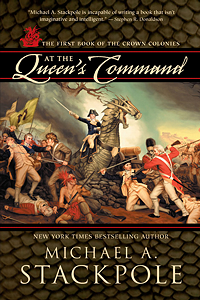At The Queen’s Command
Have to love the Internet. I open up a web-browser, head to a social networking sight, and got to see the cover for At The Queen’s Command making its way through those interwebtubethingies. This cover is great. I just love it to death. It’s a gorgeous cover and it has that, “Say what?” factor going for it.
I mean, it’s clearly an American historical novel.
And then you spot the dragon.
Even folks who muddled through high school history—barely avoiding being bored to death—will be pretty sure there were no dragons in the American Revolution. (Technically this is the French and Indian War, or Seven Years War, depending on which side of the Atlantic you’re on.) And, trust me, this version of the French and Indian War won’t bore you to death.
It’s really kind of funny but it takes seeing a cover to make a book real. Earlier today I shipped a copy of the manuscript off to my father. It was just a pile of pages. But seeing the cover means it’s a book—whether you read it in paper or bytes. With a cover wrapped around it, the book can take up shelf space (or megabytes). It becomes something tangible when, prior to that, it was simply mind-movies shared with those who read the script.
This cover really captures the nature of the book, both because of the historical analogs and the themes I get to play with. I could have written a straight alternate history but, as I did with Eyes of Silver, I chose to change place names and significantly alter some historical aspects. This wasn’t because I couldn’t do, or didn’t want to do, the research. My degree is in history, I love the American Colonial period and to make the changes I made, I had to do the research anyway. Kind of like breaking a bone to set it again, I had to break history to rebuild it.
I did this for two reasons. First, I really didn’t want readers going into the book trying to figure out who is whom. While there might be a character who eventually assumes a very George Washington type position, no characters are modeled on George Washington. The fact is, history calls for someone in that position, so that position will be filled. I opted out of using direct analogs and modeling characters on historical figures because in changing the world, I also changed some of the dynamics which made those individuals who they are.
Second, I really wanted to mess around with aspects of history to sharpen the contrast on certain issues. For example, Tharyngia is the France analog (the name taken from Lotharingia, which was once a nation that had a lot of French territory as part of it). I chose to have Tharyngia’s revolution before the American Revolution. I also framed their revolution as a secular and scientific one, overthrowing a king who had ruled by divine right. This establishes a meritocracy governed by the Laureates—not quite a Randian paradise, but definitely an irreligious state.
I’m really happy with the book. It has all the stuff in it that a book should: action, adventure, discovery, politics, romance, humor, suspense, magick, military exploits and glimpses into a world we might, save for the vibration of some string out there, be living in.



 31. Aug, 2010
31. Aug, 2010 








10 Responses to “At The Queen’s Command”